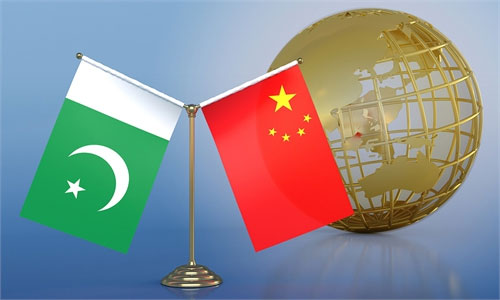It is extremely encouraging news that the first freight container from China has arrived in Pakistan under the CPEC agreement. CPEC is undoubtedly a game-changer, yet it seems that many still find it hard to believe in its potential. This is primarily due to some international forces that do not view this monumental project favourably. From the very inception of this project, attempts were made to create situations in Pakistan that led to the cancellation of the Chinese President’s visit. Since then, various pressures have been exerted on CPEC, both internally and externally.
Efforts were made to overthrow governments that viewed CPEC as a cornerstone of Pakistan’s development. Politicians who stood firm against global pressures and succeeded in executing this agreement with China were sidelined. Additionally, campaigns against CPEC were launched, articles were published opposing it, and even attacks were carried out on Chinese nationals—all part of a conspiracy to sabotage this grand project. However, it is commendable that China has always stood by Pakistan on this front.
Now is the time for Pakistan to make a clear and resolute decision about its direction and priorities. There is no doubt that international circumstances have been engineered to create skepticism and opposition to CPEC, both within and outside Pakistan. Propaganda has been spread, claiming that CPEC could turn Pakistan into a colony of China. This narrative has been widely circulated in the media during the previous government’s tenure, leading to doubts among the younger generation about this project.
However, those spreading such misinformation are against Pakistan’s progress. They are people who, without proper research, become part of any propaganda campaign. Despite the clear guidance in our religion to verify information before passing it on, social media in our country has become a free-for-all, rife with vulgarity and baseless narratives. The government has taken strict measures to curb such practices, causing inconvenience to internet users. While these measures have been criticized, the unregulated use of social media has fostered ignorance and falsehood, becoming part of anti-Pakistan propaganda.
Similar propaganda has targeted CPEC. Yet, the majority of Pakistanis and intellectuals recognize its importance and benefits. We must collectively strive to make this grand project a success. It is not just China’s interest at stake, as some have claimed in the past, but it benefits Pakistan and the entire region. The opposition to Pakistan’s development is well-known, and such elements have worked to destabilize regions like Balochistan, launching organized campaigns to create a negative perception internationally. These campaigns trace back to countries and entities that are inherently unhappy with Pakistan’s progress, including neighbouring countries with vested interests.
Under the New World Order, a paradigm shift is occurring. The Middle East is undergoing rapid change, while the United States, Russia and China pursue their respective interests. The friendship between Pakistan and China is a global example of strong bilateral ties. China has always supported Pakistan, especially when we have felt isolated in the international community—a fact repeatedly acknowledged by Prime Minister Shehbaz Sharif.
Under CPEC, China is investing $62 billion in Pakistan across infrastructure, agriculture, energy and water projects. This project is a vital component of China’s Belt and Road Initiative, which began in 2013 during the PML-N government. In April 2015, both countries signed agreements worth $46 billion on 51 Memorandums of Understanding (MOUs). A long-term framework was signed in November 2017, extending from 2017 to 2030, divided into three phases: the first to be completed by 2020, the second by 2025 and the third by 2030.
CPEC, referred to as “One Plus Four,” includes four major components: Gwadar Port, energy, communication infrastructure and industrial zones. It aims to generate 17,045 MW of electricity, improve road and railway networks, establish new optical fibre connections, enhance ports like Gwadar and promote trade. Of the $19 billion invested so far, 27 projects have been completed, while 63 projects worth $35 billion are in progress. In Gwadar, three port projects and six welfare initiatives have already been completed.
CPEC is said to have provided Pakistan with unprecedented economic opportunities, serving as an engine of economic growth and potentially increasing Pakistan’s GDP growth rate by 2-3%. With the efforts of the current government, CPEC has entered its second phase, focusing on industrial and agricultural cooperation, Gwadar’s development and socio-economic progress. Efforts are underway to accelerate its pace.
This is the time for Pakistanis to understand the importance of CPEC. It is not merely China’s program but has the potential to propel Pakistan’s economic growth at a jet speed. Unfortunately, the lack of effective policymaking and internal collaboration has hindered its progress. Many within the country have aligned themselves with forces opposed to CPEC. However, we must unite and work under one flag for Pakistan’s development. This vision aligns with the ideals of Quaid-e-Azam Muhammad Ali Jinnah.
Following the collapse of the Soviet Union, China is emerging as a superpower. Naturally, the existing superpower does not wish to see its hegemony challenged. It is encouraging that China has always respected Pakistan’s foreign policy. Meanwhile, the US is taking measures that may force Pakistan to adopt a clear and decisive stance. While the US has hinted at imposing sanctions, Pakistan must remain resolute. The country’s strategic importance is undeniable and destabilizing Pakistan serves no one’s interests.
The government believes that CPEC Phase-II will bring great opportunities in sectors like agriculture, IT and minerals. However, Pakistan has faced deep polarization over the years which the media can help reduce.
Teachers also have a key role in shaping young minds and preparing future generations. Schools and colleges can help students understand the importance of CPEC. If the media shares accurate information, it will create informed opinion leaders and educators are ideal for this role.
Media is a game changer that can unite the nation and promote CPEC’s benefits effectively. (zabirsaeed@gmail.com)










